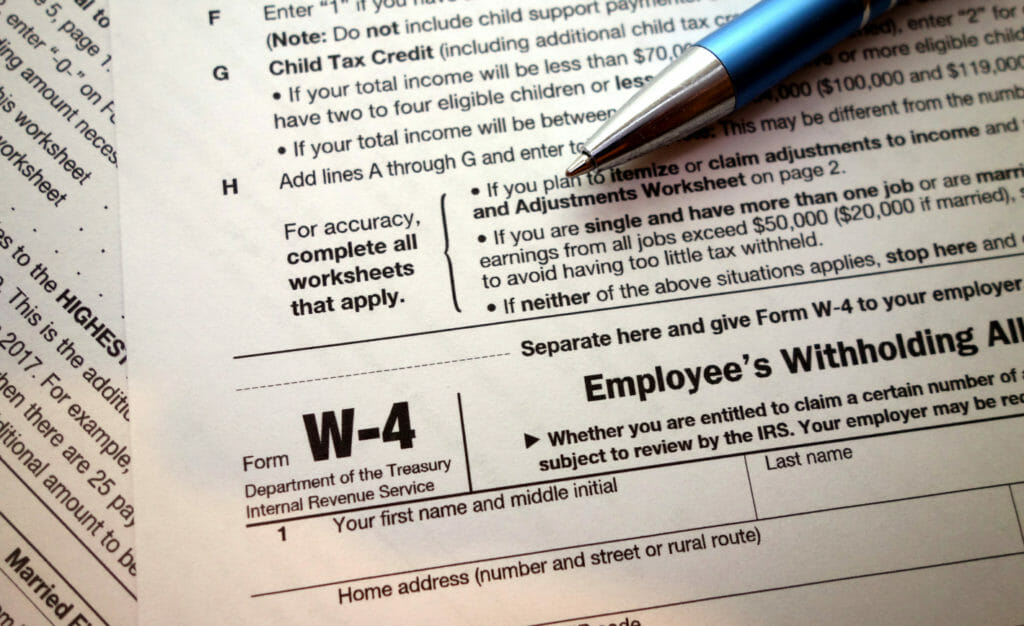
Significant Changes in W-4 Withholding May Be Coming in 2019
The following blog is based on recent information that Accu Data Workforce Solutions has received from the IRS. We are presenting this in order to keep you in the know. However, please note that these are only “proposed” rules and as of yet are not confirmed. THERE IS NOTHING THAT YOU NEED TO DO AT THIS TIME. Accu Data will publish clarifications in the future as we receive further updates.
Hang on to your hats: By early autumn, the IRS says it plans to release a revamped 2019 Form W-4. The release of the W-4 Employee’s Withholding Allowance Certificate is earlier than previous years in order to give software developers and payroll firms additional time to adjust to changes in the new tax law (called the Tax Cuts and Jobs Act, or TCJA) that will affect the filing of returns for the 2018 tax season. Employees use the Form W-4 to declare their marital status and withholding allowances in order to calculate federal withholding rates. States also use the form for the purposes of declaring state tax withholding for the year.
The revised 2019 Form W-4 brings with it some good news: IRS officials describe the new form as being “cleaner and more robust” and more streamlined than the old form. This, they say will allow small-to-medium sized business and payroll firms a smoother transition to the new tax laws.
Employees won’t be required to update their Form W-4 in 2019; however, tax and payroll experts insist it will be wise for them to do so. For those who opt not to complete the form, employers can still use the information included on the 2018 Form W-4.
There are a number of significant changes to the Form W-4 for 2019. One of the most prominent changes is the elimination of Line 5: “Total number of allowance you’re claiming.”
Other highlights of the new Form W-4 for 2019 include:
- New Marital Status Box – Head of Household: The IRS has added a third withholding calculation/table to correspond with this new marital status declaration; this is in addition to the existing tables for Single and Married Filing Jointly.
- New Line 5 – Additions to Income: This revised section asks employees to enter their estimated nonwage income not subject to withholding, such as interest and dividends. Up until this year, employees who earned significant nonwage income needed to convert this income to equivalent per-payroll additional amounts to withhold. With the new Form W-4, Line 5 amounts will be full-year estimates; as such, employer payroll systems will have to be revised to include these full-year amounts in withholding calculations.
- New Line 6 – Itemized and Other Deductions: The new Line 6 asks employees to enter their estimated subtractions to income based on expected deductions (such as state and local taxes, mortgage interest, and charitable contributions). In years past, employees had to convert deductions into equivalent withholding allowances. As with the new Line 5, amounts entered on the new Line 6 will be full-year estimated deduction totals. And, similar to above, payroll systems will have to include full-year amounts in withholding calculations.
- New Line 7 – Tax Credits: With this revision, employees are asked to enter the full- year amount of any tax credits for which they expect to qualify, such as the child tax credit. As a reminder, the 2017 TCJA greatly expanded child and dependent tax credits. In years past, tax credits were translated by employees into additional withholding allowances. With the new 2019 Form W-4, full-year tax credit amounts are directly entered into payroll systems. Of significant importance here, any tax credits should only be entered for the highest paying job in households with multiple incomes. Taxes may be significantly under-withheld for a household if both spouses enter the full-year credit expected; that can result in a large tax amount due at the end of the tax year. At the same time, taxes may be significantly over-withheld if neither spouse enters the total tax credit amount; this can result in reduced net paychecks during the year — and a large tax refund at the end of the tax year.
- New Line 8 – Additional Household Income Due to Multiple Jobs: With the new changes, employees, if applicable, will enter the full annual income associated with any second job. A second job is considered one that an employee holds, or the annual wage income of any spouse if they are employed. Additional income from wages should only be entered for the highest-paying job in households with multiple incomes. There are special instructions for households with more than two incomes. Up until now, employees used a Form W-4 worksheet to determine a specific additional amount to withhold per pay period.
Now employers will include these full-year amounts in withholding calculations to determine the appropriate tax bracket and withholding rates for the employee. Instructions will offer a calculation to estimate an additional tax amount to withhold for each pay period (which was the solution prior to 2019). Employees will also be able to consult the online calculator, or IRS Publication 505, Tax Withholding and Estimated Tax, to bypass Lines 5 and/or 8.
- Line 9. Additional Amount, If Any, You Want Withheld From Each Paycheck: This line has not changed for 2019. Employees will still to be able to enter an additional per-pay period amount to withhold. It’s the only entry with a per-pay period result.
In most cases the TCJA will result in reduced taxes; some employees have already noticed an increase in net pay and a reduction in income tax deductions. However, officials note that while the new withholding tables are as close to accurate as possible, changes to withholding may not exactly match changes in actual full-year tax liability. Some employees who traditionally received a tax refund at the end of the year may actually end up owing taxes for 2018 under the new law. And the elimination of personal exemptions makes the new law even more challenging.
Now more than ever it’s smart to partner with an expert in the rapidly changing employee payroll landscape. As always, at Accu Data we stand ready to help your company every step of the way. Please stay tuned for additional information regarding the 2019 W-4 form as it becomes available.

